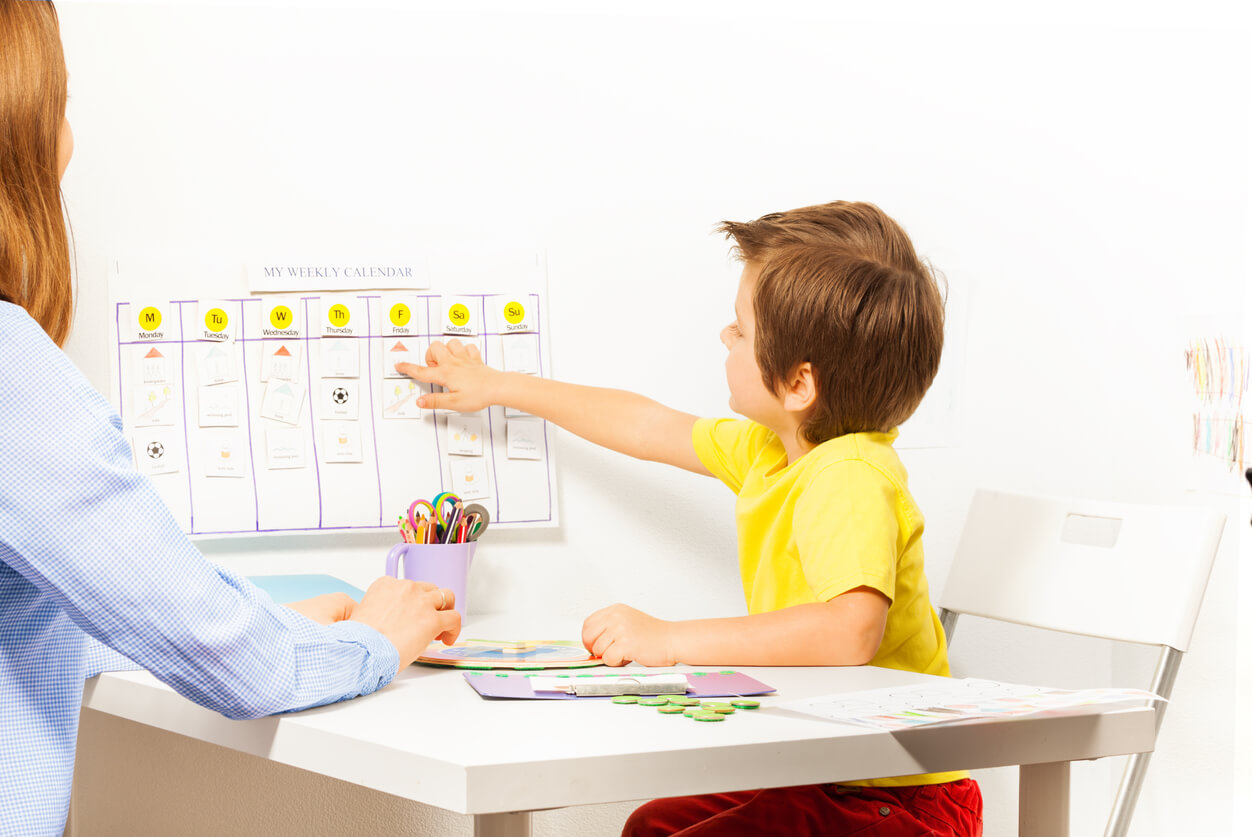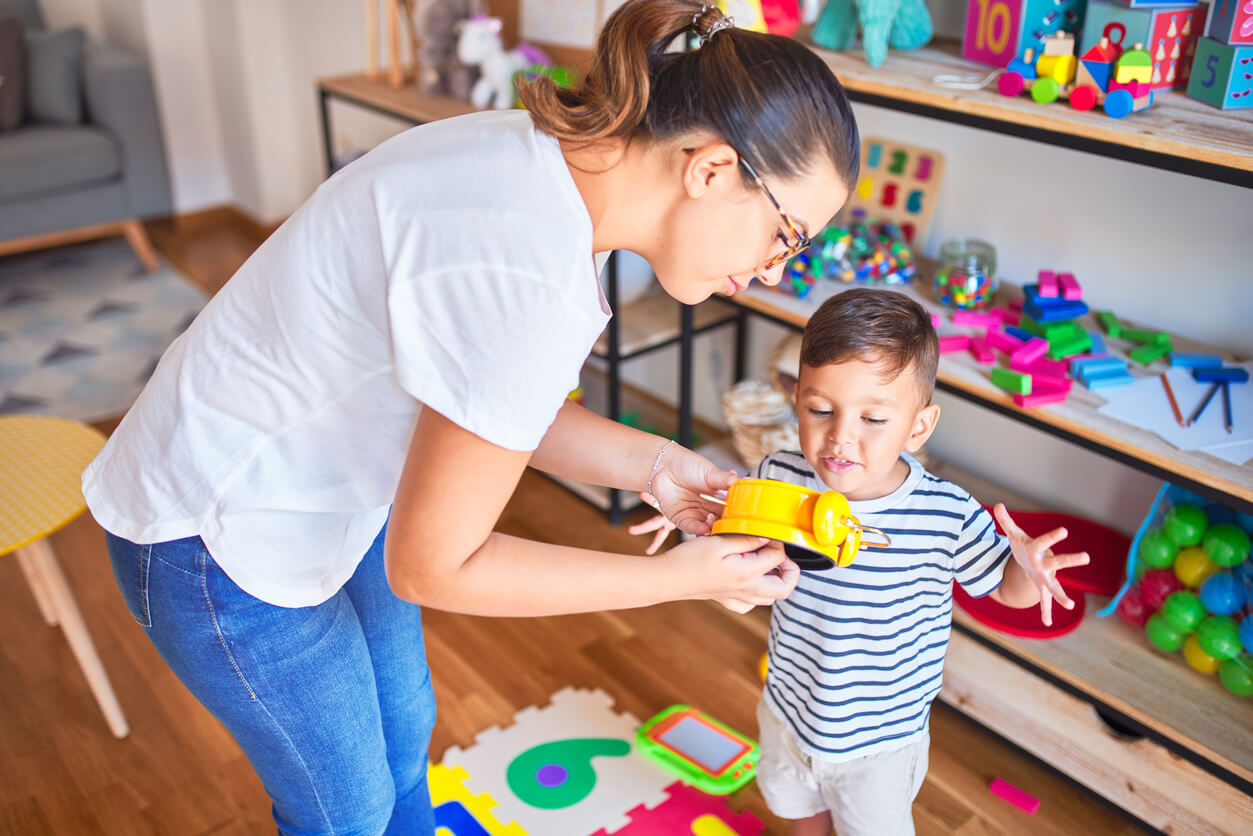Children and Their Understanding of the Concept of Time


Written and verified by the psychologist Mara Amor López
Young children don’t understand time as we adults do. Therefore, the task of explaining to them the passing of days, months, or years can be a difficult one. In this article, we’ll tell you more about children’s understanding of the concept of time.
Little ones don’t understand that there are two months until their birthday or 10 months until Christmas comes. No matter how much we explain it to them, they’ll ask how much time is left and they won’t understand the value of time. However, we can help them to understand it better little by little. Let’s get started!
Children and the concept of time, how they perceive it
We can say that time is something impalpable, as it can’t be seen, touched, or measured if we don’t have the necessary instruments to do so. You should know that preschool children don’t understand the passage of time. It’s around the age of 6 or 7 when they begin to know how to read and write, when they begin to understand time on a clock, and when they start seeing the passing of days and months on the calendar.
Many times, parents use phrases such as “in half an hour, we’ll be there,” “your birthday is 3 months away,” “I’m coming in 5 minutes,” or “we’ll do it later.” And we’re sure that your children have asked you many times “when will we get there?” even if you just told them 5 minutes ago.

The 3 stages to understand time
According to Jean Piaget, there are three stages for the understanding of time that children go through according to their age:
- Lived time (0 to 6 years): The child constructs their concept of time according to the experiences they’ve had in their lives and routines (such as mealtime, bath time, or bedtime). At first, this way of perceiving time won’t have an order for them, but little by little, they’ll understand, through their routines, which things come before others, what happened yesterday, and what they’ll do tomorrow.
- Perceived time (from 6 to 12 years old): During these ages, children already begin to understand the concept of time through observation and the use of the necessary instruments to measure it: A clock, a stopwatch, or a calendar, among others.
- Conceived time (12 to 16 years old): At this stage, there’s already an understanding of time as a mental and abstract concept, so they’re able to apply it in any field.
Resources to help children understand the passing of time
Knowing Jean Piaget’s stages, it may be somewhat clearer to us why preschoolers find it difficult to understand certain expressions. However, parents can help children with the concept of time through games, activities, or crafts. Here are some ideas.
Countdown timers
Using countdown timers can be very useful, especially to let children know when they’ve to finish an activity. For example, the time to watch TV or play video games. It’s important to keep in mind that you should start with short periods of time, 10 or 15 minutes, and then increase it progressively.
Wall or table calendars
These are the calendars where you have to turn the pages to see the next month or desk calendars that work exactly the same way. On this calendar, you can write down important events and, as they happen, the child can cross them out.
Hourglasses
This resource is very visual and can be used, above all, to measure small times. For example, to indicate the time for washing hands or brushing teeth.
Circular clocks that can be manipulated
These clocks are very useful for them to learn and assimilate the elapsed time. We can tell them how to place the small hand and what happens when it’s between one hour and another. For example, if the little one hand is between 12 and 1 o’clock, it’s time to eat; if it’s between 3 and 4 o’clock, it’s time to have a snack; and, thus, they’ll begin to learn the times associated with their routines.

Calendars to wait for the arrival of an important event
We can make our own calendar to indicate, for example, when Christmas will arrive or to wait for other important events. For example, when their birthday is a month away, they can see how the days go by until the arrival of their special day.
Songs to measure time
This is a resource we can use when we want them to do an activity that lasts a short time. We know that a song lasts about 3 minutes or a little more. In this way, we can use it to tell the child that they have to get dressed while the song is playing or that they have two songs to pick up their room.
About children and the concept of time
As we’ve seen, the idea of time in children is a little different from that of adults. In this article, we’ve been able to see the stages that children go through for their understanding, as well as some resources that can help us help them understand this topic better. If we help them with this type of tool, in the end, little ones will be able to internalize certain times, even if they don’t yet understand what the concept itself means.
Young children don’t understand time as we adults do. Therefore, the task of explaining to them the passing of days, months, or years can be a difficult one. In this article, we’ll tell you more about children’s understanding of the concept of time.
Little ones don’t understand that there are two months until their birthday or 10 months until Christmas comes. No matter how much we explain it to them, they’ll ask how much time is left and they won’t understand the value of time. However, we can help them to understand it better little by little. Let’s get started!
Children and the concept of time, how they perceive it
We can say that time is something impalpable, as it can’t be seen, touched, or measured if we don’t have the necessary instruments to do so. You should know that preschool children don’t understand the passage of time. It’s around the age of 6 or 7 when they begin to know how to read and write, when they begin to understand time on a clock, and when they start seeing the passing of days and months on the calendar.
Many times, parents use phrases such as “in half an hour, we’ll be there,” “your birthday is 3 months away,” “I’m coming in 5 minutes,” or “we’ll do it later.” And we’re sure that your children have asked you many times “when will we get there?” even if you just told them 5 minutes ago.

The 3 stages to understand time
According to Jean Piaget, there are three stages for the understanding of time that children go through according to their age:
- Lived time (0 to 6 years): The child constructs their concept of time according to the experiences they’ve had in their lives and routines (such as mealtime, bath time, or bedtime). At first, this way of perceiving time won’t have an order for them, but little by little, they’ll understand, through their routines, which things come before others, what happened yesterday, and what they’ll do tomorrow.
- Perceived time (from 6 to 12 years old): During these ages, children already begin to understand the concept of time through observation and the use of the necessary instruments to measure it: A clock, a stopwatch, or a calendar, among others.
- Conceived time (12 to 16 years old): At this stage, there’s already an understanding of time as a mental and abstract concept, so they’re able to apply it in any field.
Resources to help children understand the passing of time
Knowing Jean Piaget’s stages, it may be somewhat clearer to us why preschoolers find it difficult to understand certain expressions. However, parents can help children with the concept of time through games, activities, or crafts. Here are some ideas.
Countdown timers
Using countdown timers can be very useful, especially to let children know when they’ve to finish an activity. For example, the time to watch TV or play video games. It’s important to keep in mind that you should start with short periods of time, 10 or 15 minutes, and then increase it progressively.
Wall or table calendars
These are the calendars where you have to turn the pages to see the next month or desk calendars that work exactly the same way. On this calendar, you can write down important events and, as they happen, the child can cross them out.
Hourglasses
This resource is very visual and can be used, above all, to measure small times. For example, to indicate the time for washing hands or brushing teeth.
Circular clocks that can be manipulated
These clocks are very useful for them to learn and assimilate the elapsed time. We can tell them how to place the small hand and what happens when it’s between one hour and another. For example, if the little one hand is between 12 and 1 o’clock, it’s time to eat; if it’s between 3 and 4 o’clock, it’s time to have a snack; and, thus, they’ll begin to learn the times associated with their routines.

Calendars to wait for the arrival of an important event
We can make our own calendar to indicate, for example, when Christmas will arrive or to wait for other important events. For example, when their birthday is a month away, they can see how the days go by until the arrival of their special day.
Songs to measure time
This is a resource we can use when we want them to do an activity that lasts a short time. We know that a song lasts about 3 minutes or a little more. In this way, we can use it to tell the child that they have to get dressed while the song is playing or that they have two songs to pick up their room.
About children and the concept of time
As we’ve seen, the idea of time in children is a little different from that of adults. In this article, we’ve been able to see the stages that children go through for their understanding, as well as some resources that can help us help them understand this topic better. If we help them with this type of tool, in the end, little ones will be able to internalize certain times, even if they don’t yet understand what the concept itself means.
All cited sources were thoroughly reviewed by our team to ensure their quality, reliability, currency, and validity. The bibliography of this article was considered reliable and of academic or scientific accuracy.
- León, A. T. (2011). El concepto de tiempo en niños y niñas de primer a sexto grado. Revista Latinoamericana de Ciencias Sociales, Niñez y Juventud, 9(2), 869-884.
- Urrutia Martínez, M., Ruiz Sanhueza, D. F., & Alarcón Hernández, P. (2020). Comprensión del tiempo a través del espacio: un estudio de plasticidad inducida en niños con trastorno específico del lenguaje.
This text is provided for informational purposes only and does not replace consultation with a professional. If in doubt, consult your specialist.








